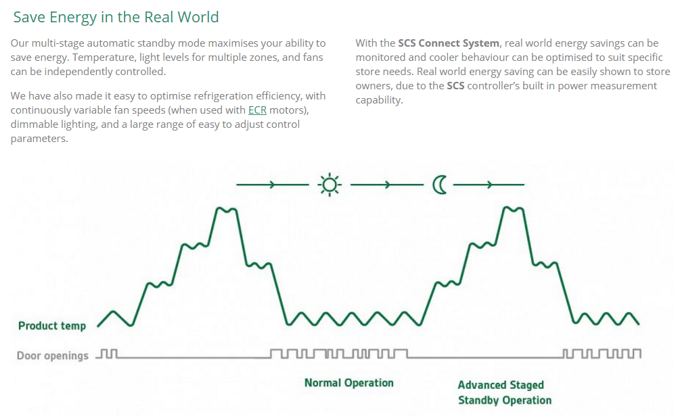When you think of the Internet of Things and the heating, ventilation and air conditioning (HVAC) industry, what first comes to mind? It might be the infamous Nest Learning Thermostat, the first connected heating and cooling system of its kind. IoT's reach extends far beyond residential applications, whether you realize it or not. The Internet of Things is truly revolutionizing the commercial HVAC industry in nine pivotal ways, from remote diagnostics to increased efficiency.
1 | Real-Time Monitoring
Internet-connected heating and cooling systems have the ability to continuously monitor conditions and system functionality with the help of smart sensors. Once information is gathered, it can immediately be shared with system managers, engineers, technicians and so on. Daikin Applied's Intelligent Equipment™ system, which is powered by a Linux OS and an Intel processor, allows users to monitor and control equipment with real-time data that's delivered to them in an easily digestible format.
Paul Rauker, Vice President of Systems and Controls at Daikin, says, "Pulling the data out is just one thing. Making it usable, executable, and having the ability to actually deliver a value-based proposition – that's the key to this."
2 | Predictive Maintenance
As Paul Rauker mentioned, retrieving the data is one thing – making use of it is where the value lies. Connected systems are able to analyze the information they gather and actually alert managers to unusual equipment behavior or system failure, which results in quicker response times and the ability to avoid potentially devastating problems. Additionally, internet-based systems help reduce maintenance and repair costs over time.
3 | Remote Diagnostics
This point goes hand-in-hand with predictive maintenance. Without the help of the Internet of Things, a problem must be recognized (in person) and subsequently diagnosed once an analysis has been performed (by a human). However, a connected system can detect a change or issue and send a notification within minutes of the occurrence. This process allows the user to review the data and issue a diagnosis from anywhere (maybe on an iPad) at any time (say, over the weekend) so the situation can be addressed immediately, ultimately saving both time and energy costs.
4 | Total Control
Consumers in our soon-to-be-IoT-ridden world don't just want a "smart" system. No, that's not quite enough. What they really want is total control. Back to residential thermostats for a second: Emerson Climate Technologies' Sensi Touch Smart thermostat (photo below) allows users to create temperature schedules, control multiple thermostats and receive humidity and extreme temperature change alerts from a single app. These days you no longer need to physically touch the systems in your house to manage them.

Sensi Thermostat // Photo via Emerson Climate Technologies
5 | System Adaptation
Sure, internet-based systems can be entirely controlled by their users, but the coolest part is that they don't need to be. The most advanced systems have actually been designed to adapt to their surroundings like never before. With the help of smart sensors, systems can measure temperature, humidity and air flow throughout an entire building as well as determine external factors such as the weather forecast and current utility rates. With this rich information in hand (or in "brain"), the system adjusts its settings to plan for upcoming situations, thus boosting efficiency. By learning how to alter its behavior based on current or upcoming situational factors, it's able to proactively create a comfortable environment instead of reacting to changes after they occur.
Example: Let's say a heat wave is due to hit your area in two days. A connected system will note this temperature spike and cool your office building down overnight – when it's most cost-effective to do so – to save energy costs and ensure the climate is comfortable when workers arrive in the morning.
6 | Continuous Comfort
Comfort is subjective. However, there is some science behind it. While you may think a comfortable room is driven solely by temperature, humidity is a major player in this equation. Humidity levels affect the amount of latent heat present in the air, and that can determine the level of comfort. As mentioned in the point above, these web-based systems are incredibly receptive. They observe and learn. They gather information and adapt. Not only are they shooting for optimum efficiency – they're also maintaining a comfortable environment (based on user behavior and external factors) at all times.
7 | Increased Efficiency
HVAC units and buildings outfitted with smart, connected sensors simultaneously track both external sources and interior performance to optimize efficiency. Remember the Daikin Applied equipment I mentioned earlier? The company has said their system can offer at least 20 percent reduction in energy costs by utilizing a technology called "demand response." Although several factors are fueling the ubiquity of IoT in this industry, the potential energy savings alone are enough to keep the fire fueled, so to speak.
Another example of energy-saving equipment is Wellington's Smart Control Solutions (SCS). The SCS product line includes intelligent electronic thermostats and energy management devices (EMDs) for commercial refrigeration systems. See the visual below to read about how this system offers cost-savings through energy efficiency.
8 | Inherent Connectivity
These smart sensors I keep mentioning don't simply pick up clues and collect data. They also enable systems to communicate directly with other systems and devices in a building without the use of a controller. IoT-capable options are replacing traditional building automation systems (BAS). BAS provide controllability, but web-based alternatives add the benefit of sophisticated data collection, analytics and greater connectivity opportunities.
Communication and connectivity are not limited solely to heating and cooling functions. Other systems, including security and lighting, could share a set of occupancy sensors with an HVAC system so all are in sync and communicating seamlessly.
One consideration when it comes to investing in new, connected systems is compatibility with older ones. While integration is possible in many cases, it could be more work than it's worth in the end. Upgrading your entire system to newer, smarter technology is probably your best bet.
9 | Focus on UX
The technologies emerging today are extremely user-friendly. Those that gloss over user experience (UX) will not thrive. Period. Connected systems are collecting massive loads of data that is then made available to users, so the ease of accessing and understanding this data is critical. If information cannot be properly digested, then what's the point? Good data is timely, accurate and comprehensible.
Conclusion
The Internet of Things is shaping the way we interact with objects as well as each other, and its impact spans a wide range of business sectors. For the HVAC industry, IoT means better managed, maintained, connected and efficient systems. But it actually means more than just a connected system – it means a smarter environment engaged in constant communication. The opportunities look pretty promising, at least from where we're sitting.





.jpg?width=176&height=56&name=MR_associatedNetwork_logo%20(1).jpg)